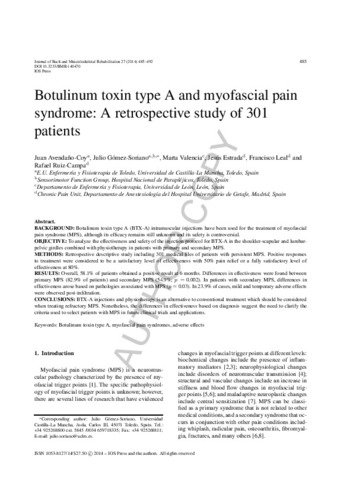Botulinum toxin type A and myofascial pain syndrome: a retrospective study of 301 patients.
Autor(es) y otros:
Fecha de publicación:
Editorial:
IOS Press
Versión del editor:
Citación:
Descripción física:
Resumen:
BACKGROUND: Botulinum toxin type A (BTX-A) intramuscular injections have been used for the treatment of myofascial pain syndrome (MPS), although its efficacy remains still unknown and its safety is controversial. OBJECTIVE: To analyze the effectiveness and safety of the injection protocol for BTX-A in the shoulder-scapular and lumbarpelvic girdles combined with physiotherapy in patients with primary and secondary MPS. METHODS: Retrospective descriptive study including 301 medical files of patients with persistent MPS. Positive responses to treatment were considered to be a satisfactory level of effectiveness with 50% pain relief or a fully satisfactory level of effectiveness at 80%. RESULTS: Overall, 58.1% of patients obtained a positive result at 6 months. Differences in effectiveness were found between primary MPS (82.9% of patients) and secondary MPS (54.9%; p = 0.002). In patients with secondary MPS, differences in effectiveness arose based on pathologies associated with MPS (p = 0.03). In 23.9% of cases, mild and temporary adverse effects were observed post-infiltration. CONCLUSIONS: BTX-A injections and physiotherapy is an alternative to conventional treatment which should be considered when treating refractory MPS. Nonetheless, the differences in effectiveness based on diagnosis suggest the need to clarify the criteria used to select patients with MPS in future clinical trials and applications.
BACKGROUND: Botulinum toxin type A (BTX-A) intramuscular injections have been used for the treatment of myofascial pain syndrome (MPS), although its efficacy remains still unknown and its safety is controversial. OBJECTIVE: To analyze the effectiveness and safety of the injection protocol for BTX-A in the shoulder-scapular and lumbarpelvic girdles combined with physiotherapy in patients with primary and secondary MPS. METHODS: Retrospective descriptive study including 301 medical files of patients with persistent MPS. Positive responses to treatment were considered to be a satisfactory level of effectiveness with 50% pain relief or a fully satisfactory level of effectiveness at 80%. RESULTS: Overall, 58.1% of patients obtained a positive result at 6 months. Differences in effectiveness were found between primary MPS (82.9% of patients) and secondary MPS (54.9%; p = 0.002). In patients with secondary MPS, differences in effectiveness arose based on pathologies associated with MPS (p = 0.03). In 23.9% of cases, mild and temporary adverse effects were observed post-infiltration. CONCLUSIONS: BTX-A injections and physiotherapy is an alternative to conventional treatment which should be considered when treating refractory MPS. Nonetheless, the differences in effectiveness based on diagnosis suggest the need to clarify the criteria used to select patients with MPS in future clinical trials and applications.
ISSN:
DOI:
Colecciones
Ficheros en el ítem





